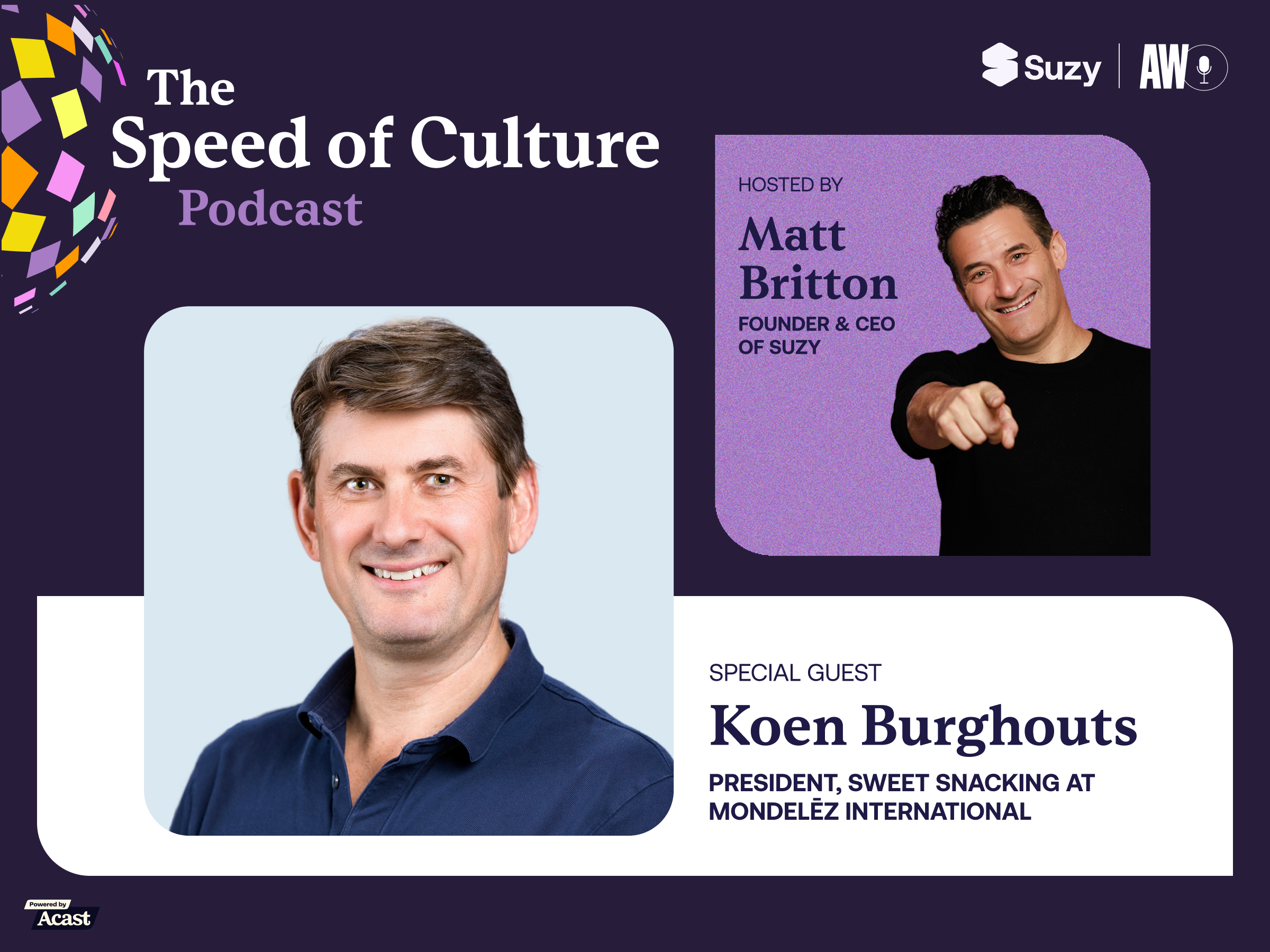1. Market Research
The first and most important function of marketing is market research. This is the process of collecting and analyzing information about:
- The unique characteristics of your customers (age, gender, culture, education, economic situation, etc.)
- The exact wants, needs, and pain points of your customers
- The buying habits of your customers
- The alternative products, solutions, and competitors on the market
- A suitable, profitable, and competitive price for your product
- The details of your distribution network
- The efficacy of marketing and advertising
Marketing teams carry out market research via customer surveys, client surveys, A/B testing, and other strategies. The more time, effort, and diligence you put into this preliminary stage of the product development process, the more successful you'll be with your products. At Suzy, our consumer intelligence tool can get an average of 500 responses in 45 minutes; this can play a vital role in helping development teams gather business-critical market research by allowing you to collaborate & co-create with real customers, so they can help you build the products they want to buy. Ultimately, the information you collect during the market research phase is essential to all of the functions of marketing below.
2. Product Planning and Development
After conducting market research, product designers can better meet the needs and wants of their customers. During the planning and development function of marketing, product developers will either seek to:
- Create something entirely new to satisfy the needs of customers identified during market research.
- Improve on an existing product/service/idea to better meet the needs of customers.
As an example, have you noticed the incredible variety of yogurt flavors at the grocery store? The smartest yogurt brands have developed new flavors in response to consumer taste preferences and demand for more variety. Yogurt brands don’t develop these flavors by chance; they perform market research to pinpoint what their customers love, and then they carry out planning and development to create those flavors.
Suzy helps you gather deep insights about consumer preferences like this to inform your product planning and development. Our tools allow you to ask and re-ask customers about their preferences, needs, and desires to rapidly test your concepts for new products and services, digging deeper into their responses to better understand why they answer the way they do. This prevents you from wasting valuable product development time on concepts that your customers won't end up buying.
3. Package Design
Package design can often be just as important as what’s inside the package. If you’re not convinced, consider in January 2009 when a popular orange juice brand reportedly spent $35 million dollars to redesign its containers and ended up facing a disaster. A few days after the launch, consumers were already criticizing the new design, especially on social media.
After a month, some consumers were having a hard time finding their favorite orange juice, and some of them simply hated the new packaging. As a result, brand-loyal customers started buying from other brands instead. Ultimately, the company had to tell its customers that it would drop the "new style" and return to the legacy design they loved. The packaging fiasco cost them approximately $50 million before it was over.
Package design can make or break your business. During this phase of the marketing process, product designers need to determine what kind of packaging materials to use (plastic, glass, tin, or paper?). They also need to assess the attractiveness, convenience, price, biodegradability, ecological friendliness, and utility of their packaging options.
At Suzy, the precise evaluation of packaging is an important part of the services we provide. By asking consumers the right kinds of questions, you can quickly assess what colors, materials, shapes, sizes, and other packaging characteristics will increase their willingness to buy from your brand.
4. Branding

If packaging presents the product with physical materials, the “branding” presents the product with art, words, feelings, and ideas. Since branding communicates with the customer and helps sell the product, it’s one of the most important functions of marketing.
Most entrepreneurs understand the necessity of branding. For example, they know that they need an attractive name and phrasing to convey a specific message that helps to sell their products. In this respect, they know that branding includes the following basic elements:
- What you call your business
- The names of your products and services
- The marks and logos that identify you
- The phrasing that describes your business
What entrepreneurs don't typically understand is the importance of congruence between their brand’s “personality/self-image” and their customers’ “personality/self-image.” A fascinating research paper – The Effect of the Congruence between Brand Personality and Self-Image on Consumer’s Satisfaction and Loyalty – explains the importance of congruence with the following statement:
“The consumer seeks certain congruence between the features of a brand’s image and the way his personality is presented (Belk, 1988; Sirgy, 1982). In other words, the consumer would express his self-image by choosing brands, where the personality appears to be close to his own personality.”
In this respect, businesses must understand the various facets of their customers’ self-image, then build their brand’s self-image to mirror their customers'. This will have the effect of attracting customers to the brand and facilitate sales. To achieve this goal, brands conduct market research designed to identify the following characteristics of their customers' self-image:
- The real self: How the customer sees him or herself. “Who I think I am.”
- The dreamed/ideal self: How customers wish to be. “What I dream I could be.”
- The real social self: How others see the customer. “The way other people think I am.”
- The dreamed/ideal social self: How the customer wishes other people would see him or her. “The way I wish other people would see me.”
At Suzy, our market research tools help companies determine the nuanced characteristics of their customers' self-images like this. We pair you with real consumers, so you can ask them questions to understand "what makes them tick." We can also help you with this process to make sure you're getting it right. The end result is more congruent branding that builds a profound and lasting relationship with your clients and customers.
5. Pricing
Pricing is a complex function of marketing. Businesses want to generate as much cash flow as possible, but sometimes it’s a lower price point that allows them to generate more income. Other times, a higher price point will have the unexpected effect of selling more products and services. When researching price, businesses need to consider:
- How much their customers can afford
- How much their customers will spend
- How much it costs to offer their product/service
- How much alternative products and services cost
- What pricing the current market expects

This kind of pricing research poses challenges for many businesses because they don't have the right market research tools at their fingertips. Suzy solves this challenge by zeroing in on customers' financial situations, spending habits, willingness to buy your product at different price points, so you can find the right price for your offerings.
6. Distribution
Distribution involves making products available for sale to consumers through wholesalers and retailers. The primary goal of distribution is to make it as easy as possible for the end customer to buy your products. To achieve this, researchers identify the most appropriate geographical locations, wholesalers, and retailers for a specific product profile. Then they seek to establish distribution channels through wholesalers and retailers to bring the product to these places.
The distribution phase of marketing involves getting clear answers to the following:
- Where (in what geographical locations) do we find our target consumers?
- Where (in which stores/retail locations) do our target consumers look to purchase our products?
Suzy can help with answering these questions by allowing you to ask consumers directly about their shopping, media consumption, and other habits in different states and regions within the United States. In this way, Suzy takes the guesswork out of deciding where to position your goods and services for sale so your products have a better chance of flying off the shelves (instead of collecting dust).
7. Selling
The final function of marketing is “selling.” Most businesses use high-tech customer relationship management (CRM) tools to boost their sales. They also rely on the teachings of sales gurus. We love the inspirational one-liners of these gurus:
“Our greatest weakness lies in giving up. The most certain way to succeed is always to try just one more time.”
— Thomas Edison
“Become the person who would attract the results you seek.”
— Jim Cathcart
“I have never worked a day in my life without selling. If I believe in something, I sell it, and I sell it hard.”
— Estée Lauder
“Thoughts become things. If you see it in your mind, you will hold it in your hand.”
— Bob Proctor
Still, it's important to diligently research and test your sales strategies before implementing them on a grand scale, as this will make the sales process a breeze instead of a constant, uphill battle. By using the market research tools at Suzy, we can help you test & verify customer intent for a product, so that you can have these stats next time your sales team goes into a meeting with a major retailer.
Hit the Bullseye Every Time with Suzy
Suzy's market research tools take the question marks out of your business and marketing strategies, so you can bring your ideas to market with absolute confidence. Contact our team to learn how our tools can improve the way you do business.
.webp)







